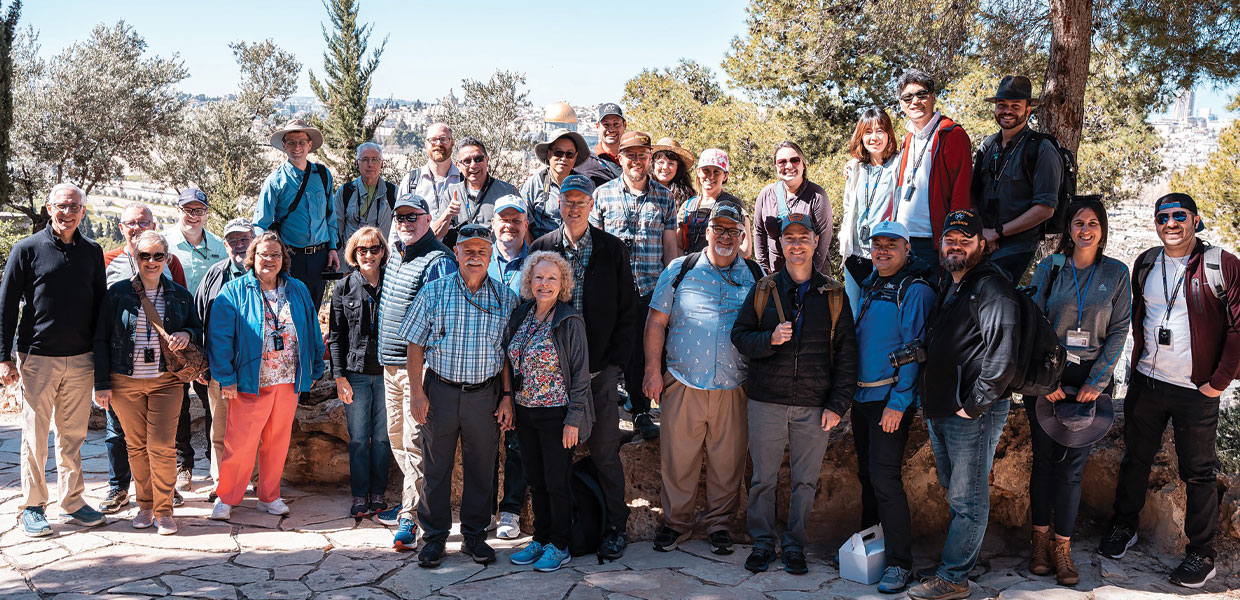
Joel Sutherland
I followed the person in front of me as we descended flight after flight of stairs, slowly penetrating the darkness below in a single-file line. We were somewhere underneath the City of David, the old part of the city of Jerusalem. The goal was to walk through Hezekiah’s Tunnel, a channel carved from solid rock which brought water from the Gihon Spring into the city at the Pool of Siloam. I was not prepared for what we came to first, however. Turning a corner, we saw what appeared to be a pile of large boulders, stretching up beyond where we had come from. I looked around at the signs and watched the short video playing on the screen in front of me. We were outside the city and the pile of boulders was actually the water shaft that Joab had climbed up in order to allow David and his army to take the city of Jebus, which became David’s capital city, now known as Jerusalem.
My eyes suddenly got misty and my voice caught as my wife asked if I wanted a picture in front of it. David has been one of my favorite characters in the Bible since I was a small child, and standing here, where such a pivotal moment in his life occurred, was overwhelming.
This was a feeling that often welled up inside me throughout the 10-day trip to Israel and Jordan, March 9-19, 2023. I was with a group of pastors and conference administration, exploring a few sites in Israel and Jordan, led by Michael Hasel, Ph.D., professor of archaeology at Southern Adventist University in Collegedale, Tennessee.
As a pastor, I thought I knew the Bible well. Yet, with all my training and knowledge, I was unprepared for how this trip would change my life. It was like putting on a pair of 3D glasses after only ever seeing a faded, black and white pencil sketch. Stories suddenly made sense. I could envision what was going on around the dialogue and brief descriptions we find in Scripture.
One life-changing moment occurred at biblical Caesarea Philippi, a place now called Banyas. This is where there is a cliff and the remains of several temples for pagan gods. Behind the temple of Augustus was a cave called the Grotto of Pan. It was also referred to as the Gate of Hell. This is where Jesus asked His disciples who they thought He was. Peter responded that Jesus was the Christ, the Son of the living God. Jesus then, with the cliffs towering above Him, made this profound statement: “I say also unto thee, that thou art Peter (pebble), and upon this rock (pointing to Himself) I will build my church; and the gates of hell shall not prevail against it,” Matthew 16:17. I can see Him gesturing back toward the temples and the Gate of Hell as He said this. No earthly power could overcome the Church He was founding.
Time and time again the Bible came to life during that trip. We sat on the Mount of Olives, overlooking the city of Jerusalem and the Temple Mount, where Jesus stood and wept for His people. We stood on the temple steps where Jesus and the apostles spent so much time teaching and healing. We marveled at the depth of the Pool of Bethesda where a paralyzed man miraculously picked up his bed and walked. We sat in a boat on the Sea of Galilee as the rain reminded us of several dark, stormy nights which provided a pronounced backdrop for several miracles. We prayed at the Western Wall of the Temple Mount in Jerusalem. I experienced a full-circle moment when I walked through the six-chamber gate of Lachish, a spot I had heard so much about during my time at Southern Adventist University, and whose destruction I had seen so accurately depicted on reliefs taken from King Sennacherib’s palace walls and displayed in the British Museum in London.
Space prevents me from talking about our visit to Petra, Dan, Hazor, the Valley of Elah, Masada, Herodium, Bethlehem, Jerash, Capernaum, Qumran, the Dead Sea, and so many other places. I know this trip will not only transform the personal devotional life of those who participated, but it will also transform the preaching and teaching of these Kentucky-Tennessee pastors as they share with fresh insight and passion about a place they have not only read about, but one they have also touched and seen for themselves.
is the Kentucky-Tennessee Conference ministerial director.
Kentucky-Tennessee | June 2023



Comments are closed.